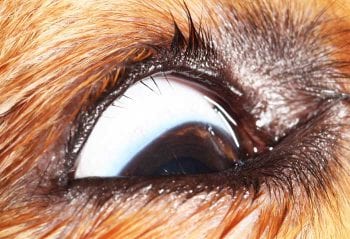28 Oct 2019
A clinical canine distichiasis case
Alberto Palella Gómez discusses appropriate actions regarding the instance of a dog with a history of moderate eye discomfort.

Figure 1. Bilateral upper and lower lid distichiasis, with epiphora in both eyes.
Lenny is a three-month-old male entire crossbreed presented to you with a history of moderate discomfort in both eyes, which were often blinky.
The owner also reports that both eyes often looked wet (Figure 1). These episodes have been intermittently happening for the past few weeks.
After performing a full ophthalmic examination, you confirm Lenny has signs of chronic epiphora in both eyes in the form of moistening of the medial canthus and periocular skin. Using focal illumination, you detect several long “extra” eyelashes coming out of the openings of the meibomian glands from the lower and upper eyelid bilaterally (Figure 2).
No signs of keratitis were present and fluorescein uptake was negative. The remainder of the ophthalmic examination and physical examination proved to be unremarkable.
Question

You are quite confident that those “extra” eyelashes coming out of the openings of the meibomian glands are consistent with distichiasis. But are these aberrant lashes to be blamed for Lenny’s chronic intermittent ocular irritation and epiphora? If so, what treatment options are available/would you recommend?
Answer
Firstly, the term distichiasis refers to single or multiple hairs arising from the meibomian duct openings on the free eyelid margin. The meibomian glands are modified hair follicles that secrete the lipid component of the tear film, and distichiasis develops from undifferentiated gland tissue. Both lids can be affected in the same eye, and the condition may be unilateral or bilateral.
Distichiasis is considered to be inherited and occurs frequently in predisposed breeds – including, among others:
- American cocker spaniel
- English cocker spaniel
- flat-coated retriever
- boxer
- bulldog
- dachshund
- Jack Russell terrier
- cavalier King Charles spaniel
Irritation caused by distichiasis leads to variable degrees of increased blinking; moisture on the margins of the eyelids; and corresponding corneal lesions such as oedema, neovascularisation and pigmentation. Occasionally, corneal ulceration will be present and although the cilia may be directly responsible, self-trauma may also be involved. Moreover, secondary entropion may develop, or in case of primary entropion, distichiasis may secondarily cause further irritation.
Management of distichiasis can be challenging, both with regards to determining whether the aberrant lashes are the cause of the ocular discomfort and also with regards to achieving permanent removal of the distichiasis with a single treatment.
Distichiasis is normally an incidental finding in many of the predisposed breeds where the number of distichia present does not necessarily correlate with the intensity of the clinical signs. For instance, many of the affected dogs may never show any obvious signs of ocular irritation.
However, in other patients, even the presence of one or two distichia can be associated with marked signs of ocular irritation, including corneal ulceration. As a rule of thumb, it can be considered that if distichia are to cause any clinical problems, they are more likely to do so from puppyhood onwards, and in cases of older patients with no history of ocular irritation throughout their lives, it is prudent not to assume the distichiasis is to be blamed for the clinical signs.
Overall other causes of ocular irritation (for example, keratoconjunctivitis sicca, ectopic cilia or foreign body) should be considered and ruled out in both young and older patients.
Treatment for distichiasis can be sometimes challenging as most treatment options may fail to allow removal of all the offending lashes with one procedure. The simplest treatment option without requiring anaesthesia is manual epilation by Bennett cilia forceps at approximate intervals of four to five weeks. However, this may be frustrating and unrewarding as the hair will grow back after epilation, but it should be used to confirm if the clinical signs are related to the distichia.
For permanent treatment – and bearing in mind these procedures require anaesthesia and, more importantly, adequate magnification – the hair follicle needs to be eliminated or removed, or the abnormal lashes redirected. Methods vary – from diathermy electroepilation, electrocautery, high-frequency radio hyperthermia and electrolysis to cryotherapy, partial resection of the distal tarsal plate and Hotz-Celsus. It is important to notice that all surgical treatment options may damage the meibomian glands, except for the Hotz-Celsus repositioning, and can result in lid scarring and/or loss of periocular pigmentation.
Knowing the contribution of the meibomian glands to the precorneal tear film, instability or poor quality of the tears needs to be monitored following the surgical procedures.
Take-home message
When presented with a case of distichiasis, it is important to carefully consider whether these aberrant lashes are the cause of the ocular clinical signs of discomfort and irritation. The fact many techniques are described to treat this condition may indicate that none of them are perfect and, therefore, it can prove to be a frustrating and challenging condition to treat in some cases.
Repeated procedures may be required as regrowth of the distichia is possible. Therefore, referral to a veterinary ophthalmologist is often indicated to determine whether the patient would truly benefit from treatment and to decide which procedure would be the most appropriate for each particular case.
Acknowledgement
The author would like to thank Rodrigo Pinheiro de Lacerda DVM, DipECVO, MRCVS, and Samuela Mazzucchelli DVM, DipECVO, MRCVS, for their assistance in reviewing this article.
Latest news

